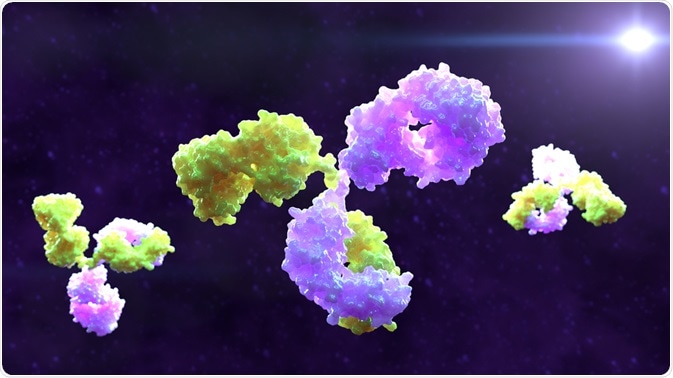While traditional monoclonal antibodies (mAbs) bind one type of antigen, bispecific monoclonal antibodies (BsMAbs) can bind two unique types of antigen.

Image Credit: Alpha Tauri 3D Graphics/Shutterstock.com
BsMAbs can be separated into two main categories based on structure. Fc-based BsMAbs are similar to normal mAbs, with an Fc region and two Fab regions. However, the Fab regions of BsMAbs are structurally different, allowing the antibody to bind two distinct types of antigen.
Fragment-based BsMAbs don’t have an Fc region. They are formed of two or more different antibody fragments joined by a peptide linker. This makes them much smaller than Fc-based BsMAbs, allowing them to more easily penetrate tissues.
Fragment-based BsMAbs
Whereas Fc-based BsMAbs allow the antibody to bind two antigens while also binding immune cells and initiating an immune response, fragment-based BsMAbs often act similarly to mAbs but with a reduced size. One antibody fragment binds an antigen on a foreign or malfunctioning cell, while the other initiates the immune response.
The small size of fragment-based BsMAbs reduces the distance between the target cell and the effector cell. This can allow more efficient killing of the target cell compared to normal mAbs.
The smaller size also results in a shorter half-life and a quicker clearance rate from the body. This can be beneficial for certain medications where the antibody may have significant toxic effects, like in some cancer medicines.
For example, the BsMAb Blinatumomab binds to CD3ε on T cells and CD19 on B cells, inducing the killing of the B cell. CD19 is most commonly expressed in malignant B cells in leukemia and lymphoma, so this antibody is an effective anti-cancer drug.
Blinatumomab was approved for use in 2014 and had shown high cytotoxicity at very low concentrations. In early trials it was shown to have significant efficacy at concentrations of only 10–100 pg/mL, making it highly effective compared to other immunotherapies at the time.
Fc-based BsMAbs
Where there is not a need for small size and a short half-life, it is preferable to include an Fc region, since this allows the drug to produce a stronger immune response and improves stability.
This is particularly useful in the transportation and administration of the medicine — as many fragment-based BsMAbs lose activity after around 48 hours at room temperature. Therefore, this can reduce the need for refrigeration.
In addition to the logistical advantages of Fc-based BsMAbs, they also have the medical advantage of attracting multiple cells to the target site, with the presence of an Fc region allowing a strong immune response. This increases the chances of killing any compromised or foreign cell.
Production of Fc-based BsMAbs is relatively inefficient. Mouse hybridomas expressing antibodies targeting one of the two target antigens are produced. The fusion of the two hybridomas forms a quadroma cell, and assembly of the immunoglobulin (Ig) light and heavy chains from the parent cells produces parental and hybrid antibodies.
This process results in up to 10 different Ig structures, only one of which is bispecific, and extracting the BsMAb can be a difficult and time-intensive process. The development of a rat/mouse quadroma has reduced the randomness of assembly, allowing easier purification.
Catumaxomab was the first BsMAb produced by this technology that was approved for use in Europe. It binds EpCAM antigens on metastasizing cancer cells and CD3 on T cells, while the Fc region activates I-, IIa- or III-positive accessory immune cells.
This attracts multiple different immune cells to the tumor site, which results in a complex immune response and T cell-mediated killing of the cancer cell.
Disadvantages
There are still very few BsMAbs in use. One reason for this is that the Fc region in Fc-based types can cause unintended immune responses. Fc receptors can often bind to surface proteins on a variety of different immune cells, leading to a complex response that is difficult to predict.
BsMAbs are also often associated with a high cost. While extensive clinical trials contribute to this, these antibodies have primarily been used in the treatment of rare cancers, so they have a very limited base of patients.
The high clearance rate of fragment-based BsMAbs can add to the cost of treatment. While they are highly effective at low concentrations, their small size can result in them being cleared from the tissues very quickly, so multiple doses are often required.
Therefore, further research is essential. Increasing the efficiency of production may contribute to reducing the cost, while new BsMAbs could help in the treatment of other cancers. Research into areas outside of cancer immunotherapy could identify other uses.
Clinical trials for novel BsMAb-based treatments are ongoing. The outcome of these trials depends on the safety of the medication, particularly in producing an unintended immune response, weighed against the benefits to the health of any patients.
References
- Linke, R., Klein, A., and Seimetz, D. (2010) ‘Catumaxomab: Clinical development and future directions’, mAbs. Taylor & Francis, 2(2), pp. 129–136. doi: 10.4161/mabs.2.2.11221.
- Löffler, A. et al. (2000) ‘A recombinant bispecific single-chain antibody, CD19 x CD3, induces rapid and high lymphoma-directed cytotoxicity by unstimulated T lymphocytes’, Blood. American Society of Hematology, 95(6), pp. 2098–2103. doi: 10.1182/blood.v95.6.2098.
- Shim, H. (2020) ‘Bispecific Antibodies and Antibody-Drug Conjugates for Cancer Therapy: Technological Considerations’, Biomolecules. NLM (Medline), p. 360. doi: 10.3390/biom10030360.
- Wang, Q. et al. (2019) ‘Design and Production of Bispecific Antibodies’, Antibodies. MDPI AG, 8(3), p. 43. doi: 10.3390/antib8030043.
Further Reading
Last Updated: Apr 22, 2020